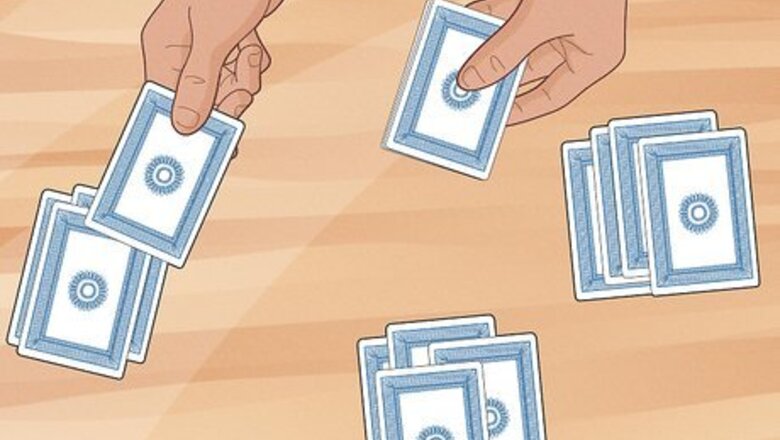
views
- Play traditional Irish Poker by playing a normal game of Omaha Poker, but each player discards down to 2 cards after the flop is dealt.
- Play the Irish Poker drinking game by dealing each player 4 face-down cards. Players guess the color, value, and suit of each card across 4 rounds.
- Continue the drinking game by taking a drink if you guess wrong, or choose another player to drink if you guess correctly.
Playing Traditional Irish Poker

Deal Like other poker games, Irish Poker is played with a dealer and 2-10 players. The dealer shuffles the deck and deals 4 cards to each player, face-down. Don’t look at your cards just yet.

Blind bet In poker, the “blind” is the buy-in for each hand, which puts money on the table before players even see their cards. The player to the left of the dealer places a “small blind,” which is a small bet, and the player to their left places a “big blind” which is usually twice that amount. These blinds are only made by the 2 players to the left of the dealer each round. After, the minimum bets each round must be equal to or greater than the big blind. In casinos, blinds are often predetermined amounts. If you’re playing at home, agree on these amounts with other players before the game.
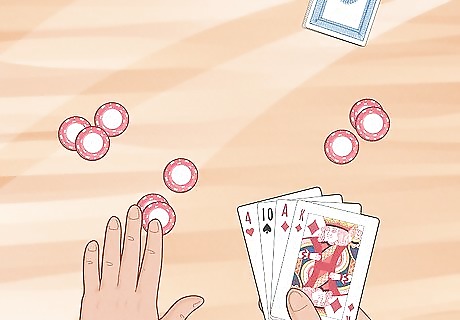
First bet Look at your starting hand. The player left of the dealer places the initial bet into the pot, and betting moves clockwise around the table. You may either call the bet (bet the same amount as the last player), raise it, or fold (exit the round). Betting ends once all players still in the game “call” the most recent raise. Strategy tip: At this point, all you have to go on is the 4 cards in your hand. Look for hands with lots of possibilities or high values, like pairs of face cards, same suits, or near-straights.

Flop The dealer deals 3 cards face-up in the center of the table. This is the “flop,” or the community cards. In Irish poker, your final hand consists of 2 cards from your private hand and any 3 cards from the flop. A card is added to the flop after each round of betting.
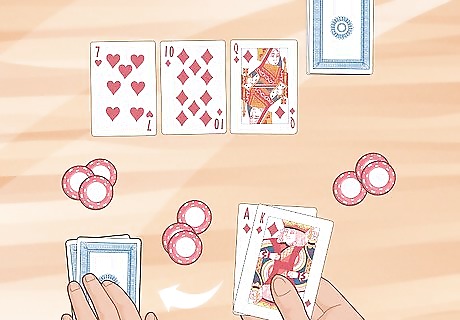
Discard Here’s the big twist in Irish Poker! In other poker games, you keep all the cards in your hand. But in Irish Poker, after the flop, choose only 2 cards to keep, and discard the other 2. This raises the stakes and narrows your options for building a hand early in the game. Take note of the cards in the flop and the cards in your hand, and see if any possible hands reveal themselves. Strategy tip: Just like with your initial bet, look for card combinations that are both high and allow some flexibility, like pairs, same suits, or cards near each other in value that may create a straight.

Second bet Now that you have the community cards on the table and the 2 cards in your hand decided, you have a better idea of your possible hands. Place your bets clockwise around the table until all players “call” the most recent raise. Strategy tip: At this point, it’s not unusual for most players at the table to fold. Don’t be afraid to bow out if the cards aren’t in your favor.
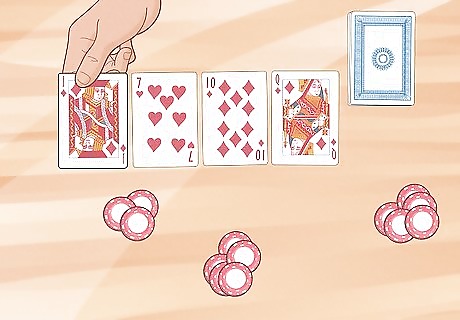
Flop and bet The dealer adds a card to the flop and players all place their bets again, taking into account their remaining 2 cards and the 4 cards now in the flop. Then deal the final card into the flop and place your final bets. This final card is called the “river.” All players remaining in the round (who haven’t folded) place their final bets.

End of the round All players still in the round reveal their cards and explain their hand. The player with the highest-value hand—a combination of the 2 cards in their hand and any 3 of the 5 cards in the flop—takes the pot! Reshuffle the cards and play as many rounds as you like. The next dealer is the player to the left of the current dealer.

Poker hands Just like standard poker, the aim of Irish poker is to have the highest-value hand. Before you start, get to know these hands, so you have an idea of when to bet high, or when to fold. From best to worst, the hands are: Royal flush: 10, J, Q, K, and A of the same suit. Straight flush: 5 cards in ascending order of the same suit, like 2, 3, 4, 5, and 6 of hearts. Four of a kind: 4 cards of the same value. Full house: 3 cards of the same value plus 2 cards of the same value. Flush: any 5 cards of the same suit. Straight: 5 cards in ascending order. Three of a kind: 3 cards of the same value. Two pair: 2 cards of the same value plus 2 different cards of the same value. One pair: 2 cards of the same value. High card: can be any card, but the higher, the better (ace is the highest).
Playing the Irish Poker Drinking Game

Setup Gather up to 13 people and deal 4 face-down cards to each. The dealer (a randomly assigned player who can also play) deals each player 4 face-down cards in a row. Players don’t look at these cards. Each player is also armed with their own beer, liquor of choice, or a non-alcoholic beverage, based on their preference.
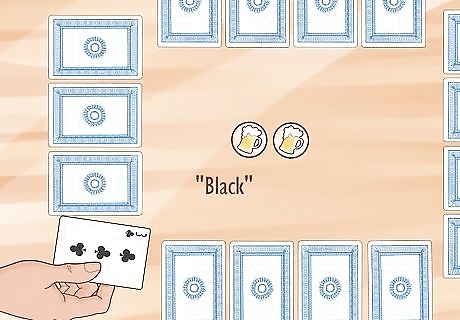
Round 1: Red or Black Starting with the player to the left of the dealer, players take turns guessing if the card on the left of their row is red or black, then flip the card. If they’re correct, they choose any other player to take 2 drinks. If they’re wrong, they take 2 drinks themself. Drinks assigned to other players can be split up however you like. Choose 2 players to each take 1 drink, or 1 player to take 2 drinks. A “drink” is usually just a large sip, not an entire beverage.
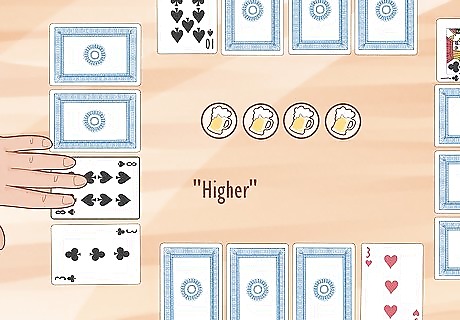
Round 2: Higher or Lower The second round sees players trying to guess whether the card to the right of their first (which is now face-up) is higher or lower in value. If they’re right, they choose a player to take 4 drinks. If they’re wrong, they take 4 drinks themself. For example, if a player’s first card is a 3 of clubs, they’d likely guess that their second card is higher, since a 3 is fairly low. For reference, the card order from low to high is: 2, 3, 4, 5, 6, 7, 8, 9, 10, Jack, Queen, King, Ace.
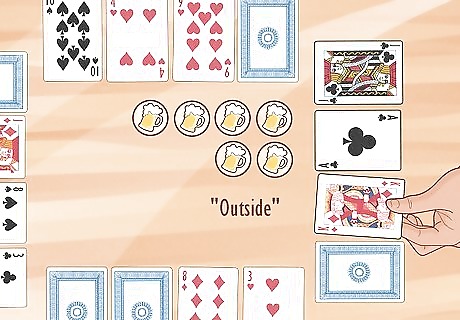
Round 3: Inside or Outside Go around the table again. This round, players guess whether the value of their third card falls inside or outside of the values of the first and second cards they flipped over. Each player chooses another to take 6 drinks if they’re correct, or take 6 drinks themself if they’re wrong. For example, if the first 2 cards are a Jack and an Ace, the player might say “outside,” since there are only 2 cards between a Jack and an Ace—the Queen and King. If the card matches one of the first 2 cards, that counts as being inside their values.
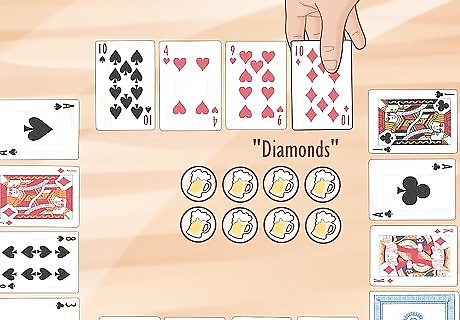
Round 4: Suit Guess whether this card is hearts, diamonds, clubs, or spades. If you’re wrong, take 8 drinks. If you’re right, choose another player to take 8 drinks.
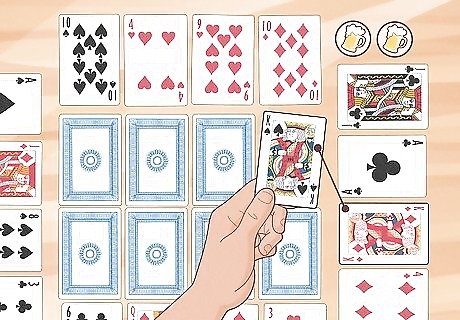
Bonus round: Ride the Bus Here, the dealer lays out 2 rows of 4 face-down cards after everyone’s cards are revealed. The first row is “assigned” drinks, the second is “taken” drinks. Reveal the first card in the first row. If any player has a matching card, they may assign 2 drinks to other players. Then, reveal the first card in the second row. If a player has a match, they must take 2 drinks themself. Continue revealing cards, alternating rows as you do. The drinks increase in number by card: 2 drinks for the first, 4 for the second, then 6, then 8.


















Comments
0 comment